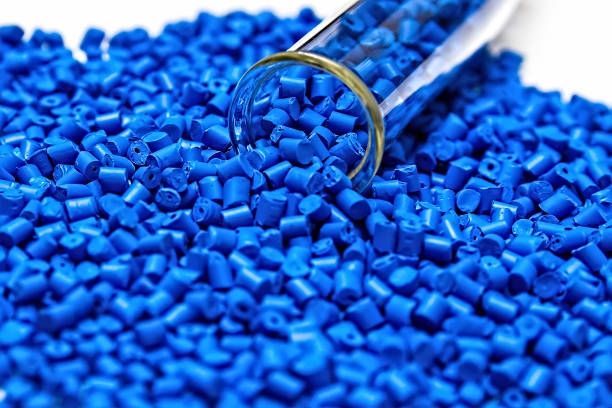Choosing the right method for granule production can have a significant impact on the physical and mechanical properties of the final compound. In this article, we provide a comprehensive overview of various granule production methods, along with their advantages and disadvantages. To learn more about this material, you can click on it.
What is polymer granule?
Granules are small plastic particles that are created by melting and molding polymers. This form of polymers is recognized as the standard raw material in the plastic industry due to features such as uniformity, ease of transport, and easy feeding into machinery.
These materials can be made from new polymers, recycled polymers, or a combination of both. Additionally, during the production process, additives such as masterbatches, fillers, and stabilizers can be blended in to impart specific properties to them.
The importance of granules in the plastics industry
Many injection molding, extrusion, and plastic molding machines are designed to accept only granules as the raw material. Its uniform shape ensures that the materials enter the machine evenly, making process control simpler. Using granules enhances the final product’s quality and also optimizes energy consumption.
Production of granules from recycled materials
With the increasing volume of plastic consumption and global attention to the environment, plastic recycling has gained significant importance. In the recycling process, plastic waste, after being collected, washed, sorted, dried, and ground, is transformed into its initial granule form.
If produced properly, recycled granules can be a cost-effective alternative to virgin polymers. However, the quality and consistency of these granules highly depend on the production method. Let’s take a look at the different production processes.
Why is the production method important?
The chosen production method affects factors such as particle size, uniformity, thermal stability, moisture content, and even the final price. For compound buyers, knowing how the granules used in the final product were produced can play a crucial role in decision-making and selecting a supplier.
Production methods
In the industry, four main methods are used for granule production. Each of these methods is suitable for specific conditions in terms of polymer type, production capacity, expected quality, and available equipment.

Method One: Strand Type
In this method, the molten polymer is extruded from the extruder and passed through filters to remove impurities. Then, the material is shaped into long strands as it passes through the die holes. These strands enter a cold-water bath to cool down and are then cut by a granulator into small pellets.
Advantages:
Low equipment cost
Suitable for small workshops
Ease of maintenance
Disadvantages:
Threads breaking during production
Requires constant operator presence
Granules of non-uniform shape and size
Method Two: Hot Die Face Cutting
In this method, granulation is carried out immediately after the molten polymer exits the die. High-speed blades are installed in front of the die that cuts the discharged material into pellets. The granules are then transported to cooling and drying paths by air flow or suction.
Advantages:
High quality and uniformity of granules
Reduced risk of contamination due to removal of water pond
Suitable for moisture sensitive polymers
Disadvantages:
Higher price of machinery
Requires high precision in cutting settings
Method Three: Water Ring Cutting
This method is a combination of dry and water-cooling techniques. After the molten material exits and is cut by the blades, the granules are thrown against the inner wall of a chamber using centrifugal force. Cool water circulates around this wall, cooling down the material.
Advantages:
Suitable for use with brittle compounds
Fast and controlled cooling
Reduce heat buildup

Method Four: Underwater Cutting
In this method, the pellet-cutting process takes place entirely underwater. The molten material, after passing through the filter, is cut directly in water. This advanced technology is designed for high-capacity production.
Advantages:
Production with uniform quality and perfectly spherical shape
Suitable for industrial production and export
Reduce dust and excess particles
Disadvantages:
High cost of equipment and maintenance
Need for expertise and experienced manpower
Comparison of production methods
| Production method | Granule quality | Equipment cost | Operator required | Production capacity | Suitable for |
|---|---|---|---|---|---|
| String | Medium | Down | Top | Low to medium | Small workshops |
| Dry | Top | Top | Medium | Top | Sensitive compounds |
| Blue ring | Good | Medium | Medium | Medium | کامپاند شکننده |
| Underwater | Very high | Very high | Down | Very high | Industrial production |
Conclusion and final recommendation
If you are a compound buyer, understanding the production method of the granules you intend to purchase can help you make a better decision. If quality, consistency, and stability of the granules matter to you, we recommend choosing raw materials produced using more advanced methods such as dry cut or underwater pelletizing.
On the other hand, if your goal is cost-saving and using recycled granules, strand-type granules can be an economical and suitable option — provided that they are purchased from a reliable supplier with high-quality control.
For purchasing consultation or placing an order for polymer granules, feel free to contact us.
Contact us: 09001630302
Send us an email: shamatejarat@gmail.com
Visit our website: https://shamatejarat.com/
For purchasing consultation or placing an order for polymer granules, feel free to contact us.


